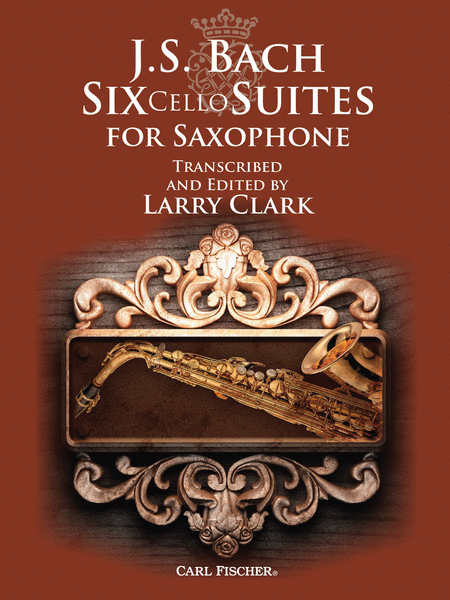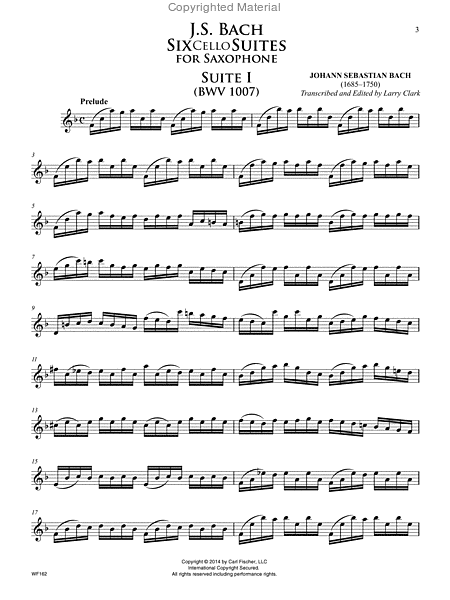J.S. Bach: Six Cello Suites for Saxophone
Transcribed and Edited by Larry Clark
-
Ships in 1 to 2 weeks
Details
Description
SKU: CF.WF162
Transcribed and Edited by Larry Clark. Composed by Johann Sebastian Bach. Edited by Larry Clark. SWS. Back To School. Score. With Standard notation. 48 pages. Carl Fischer Music #WF162. Published by Carl Fischer Music (CF.WF162).ISBN 9780825896781. UPC: 798408096786. 9 x 12 inches. Transcribed by Larry Clark.
The Six Suites for Unaccompanied Celloare some of the frequently performed andrecognizable solo compositions ever written.This pieces have been meticulously transcribedfor saxophone, keeping the integrity of theoriginal Bach compositions while making themmore idiomatic. These pieces hold up in anysetting and are now available to a whole newgroup of instrumentalist to enjoy with thiswonderfully edited collection. A must have forany serious teacher or student this edition iscompatible with all saxophones.
The six suites for unaccompanied cello by Johann SebastianBach have become some of the most popular and most frequentlyperformed pieces for any instrument. Because of the quality ofthese works, they have been transcribed for numerous instruments,including this new edition specifically for the saxophone.Much about the origins of the suites is unknown, as an originalmanuscript in Bach’s own hand does not exist. The first record of thesuites is from a manuscript in the hand of Bach’s second wife AnnaMagdalena. There are two other manuscripts of the suites that havesurvived from Bach’s time, one by J.P. Kellner, and J.J.H. Westphal,both of whom were music collectors at the time. The difficulty withcoming up with any kind of definitive collection of these pieces isthat all three of the manuscripts seem to contain errors making itdifficult to know exactly what were Bach’s intentions.The suites are enormously popular today, were not all thatpopular in Bach’s time. It really wasn’t until the famous cellistPablo Casals discovered these pieces as a child and then later in1936 recorded the suites did their popularity soar. There has alwaysbeen controversy regarding the performance interpretation ofthese works, since much of Casals’ interpretation is with a moreromanticized flare. For every cellist that has played the suites, thereare differing ways to perform these beloved works. To date there areover 80 editions of the suites just for the cello.As a trombonist in college the suites were brought to myattention by my teacher. I studied these pieces out of an existingedition for cello. In this new edition specifically for the saxophone,I have worked to keep the integrity of the original suites intact asmuch as possible, but to also add phrase markings, articulations andchange some keys to help make the pieces more idiomatic for theinstrument.To begin, I went back to the original Anna Magdalenamanuscript as the foundation. From there I added or changed phrasemarkings that would help a saxophone player to play these suitesmore like how they would sound on the cello. Anytime you decide to take on a project like this, your own opinion and performancesensibilites come in to play. I suggest that when you work on thesewonderful pieces that you alter the markings to fit your sensibilities,just how Casals did or any other person that has ever played theseworks. I have left off any dynamic choices as those are up for debateas well and each person that studies these works should make theirown musical decisions based on their own discovery, research andmusical sensibilities.As part of the editing of the suites I had to alter the octave ofsome notes to fit the range of the instrument. In most cases I triedto do this in as musical a way as possible. Also, note that I left a lotof the double or triple stops from the original cello suites intact, asthey help the performer to better understand the implied harmoniesof the pieces, and I think that many of them can be performed inan arppeggiated fashion on the saxophone to bring about a morecomplete performance. If the lowest of the double or triple stopswas out of the range of the saxophone, I placed it an octave higherwith parentheses around it. This will help you to know where Imade these adjustments so that during analysis of the suites youcan determine the inversions of certain harmonies. If the doublestops were merely octaves, I simply eliminated the lowest octavethat was out of the instrument range. When considering range, Iwas senstive to the upper range of the saxophone. Although manysaxophones have a high F≥ key, I decided to consider high F as thetop note. If notes occur above the high F, I either altered the octaveof the phrase or I put in logical and hopefully musical cue-size notesto indicate places to take the notes down out of the altissimo range.It is sincerely my hope that this new edition will help to bringthese incredibly rich pieces to many more instrumentalist whomotherwise would not get the chance to play them without this book.I hope you enjoy Bach’s works as much as I have enjoyed preparingthis edition.


 Share
Share